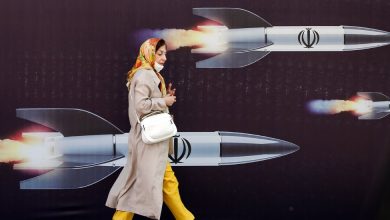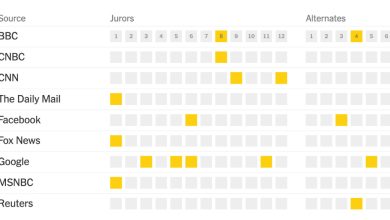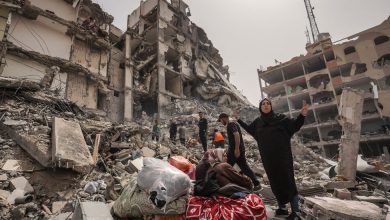A Show About European Identity Opens With a Backdrop of War

When the first visitors arrived at Jasmina Cibic’s new show at the Museum der Moderne in Salzburg, Austria, earlier this month, they were met by a pile of rubble. The room was also filled with a scent created from rose varieties named after the founding fathers of a united Europe — figures like Charles de Gaulle, the former president of France, and Robert Schuman, one of the founders of NATO.
Presented a week after Russia’s invasion of Ukraine, this symbolism, and the show’s wider interrogation of nation building in Europe, took on a significance that Cibic, an artist and filmmaker, hadn’t anticipated.
“It was not supposed to hit so close to home,” she said of the show, “Most Favoured Nation,” in a recent interview at her studio in east London. “We didn’t go as far as thinking of not opening, but it felt very strange.”
The show’s curator, Marijana Schneider, also felt a shift in the impact of the collected films, installations and on-site performances after the onset of the Russia-Ukraine war. “It gives me the chills,” she said in a telephone interview, “when you think of nation building, and how Vladimir Putin invented his own myths, and also denied the cultural history of Ukraine.”
Cibic, who was born in the former Yugoslavia (in what is now Slovenia) in 1979, has spent her career examining how nationhood and international unity are fragile performances. To her, the invasion of Ukraine by President Vladimir V. Putin of Russia is just the latest example of how statecraft is always a form of stagecraft. “Look at Putin’s long table,” she said, and look at President Volodymyr Zelensky of Ukraine, “an actor who played a president who becomes the president.”
Before “Most Favoured Nation,” Cibic’s explorations of the performative nature of politics included a film called “The Gift,” which won Britain’s prestigious Jarman Award last year. It was filmed in buildings used as the backdrops for performing political power, places like the Palais des Nations in Geneva and the Palace of Culture and Sciences in Warsaw. In the film, shot in arresting, stylish palettes, actors representing architecture, music and the arts try to persuade a committee that their discipline is the most appropriate to make up a cultural gift to an unnamed, divided nation. The film’s dialogue is assembled from archived debates from around Europe on the topic of how the state can use culture as a means of soft power.
Cibic can trace her interest in these topics back to her upbringing in Yugoslavia, where she saw how the state reinforced nationalism among the citizens by building monuments. She studied fine artin Venice, and started staging theatrical works with a group of other women from her region that played with notions of how nationhood is performed.
“We were doing these crazy performances onboard trains when they’re passing national borders,” she said. In one series, they would dress up as stewardesses on a train from Slovenia to Italy and hand out hygiene kits. “There was this question, do we need to sanitize ourselves to be able to play the part of the West?” she said.
Once Cibic graduated from Venice’s Accademia di Belle Arti in 2003, she went to Goldsmiths College in London to study further. Her first film, “Fruits of Our Land,” was part of the Slovenian Pavilion at the 2013 Venice Biennale, and was a re-enactment of the transcript from a Yugoslavian parliamentary meeting in 1957, held to establish which artworks might be suitable to decorate the country’s government building.
“With really theatrical lighting, and how the language is used in the films, it’s all a little bit overdone,” Schneider said, “so the audience really gets the point about the whole spectacle of politics.”
To Cibic, some of these expressions of power are so absurd as to be downright funny. At her studio, she pointed to a still from “The Gift” hanging on the wall of the Council Chamber at the U.N. Palais des Nations, a room decorated with a golden mural depicting heroic figures, or in Cibic’s description, “Titans on steroids.”
“It’s like a James Bond lair, and that’s the room where people sit and debate nuclear disarmament,” she said, shaking her head in disbelief and laughing.
In “The Gift” it was this theatricality, as well as the actors’ stylized movements and the almost hyper-reality of the 4K filming, that impressed the Jarman Award judges. The film made Amal Khalaf, one of the judges and a curator at London’s Serpentine Gallery, think about the ways we are constantly audience members to a performance of political power.
“We consume it all the time — we watch our parliament,” she said in a telephone interview, “and the way that Jasmina’s able to aestheticize it makes it feel jarring. You’re like, what are the consequences of this performance?”
Cibic’s current show in Salzburg frequently draws on references from the former Yugoslavia’s public performances of national identity. One installation, “Power Verticals,” includes a curtain featuring the designs for decorative columns on the Yugoslav Pavilion at various world fairs and expositions of the mid-20th century.
But other than in the show notes, Cibic avoids overt mention of any specific countries or historical periods. Despite this intentional universality, visitors to the exhibition have been most immediately connecting the work to the Russian invasion of Ukraine, Schneider said: The discussions she’s overheard on public tours of the show have mostly been about the war.
Although Cibic could not have foreseen the current geopolitical backdrop to her work, she is pleased that audiences are making these connections. “These projects that I do, they don’t exist without audiences, they’re only platforms for discussion,” she said.
This potential of Cibic’s work to spark discussions about global political power is one of its great strengths, according to Tevz Logar, who commissioned Cibic’s work for the 2013 Biennale’s Slovenian Pavilion.
Whatever lens you want to see the work through, “it still works,” he said in a telephone interview.
And while “Most Favoured Nation” might feel particularly relevant in light of the current European conflict, the practice of nation building will continue around the world, Cibic said, for as long as nations and borders exist.
“We merge, and then we break up, and we merge, and we break up,” she said. It’s “what humanity does, for some reason.”




